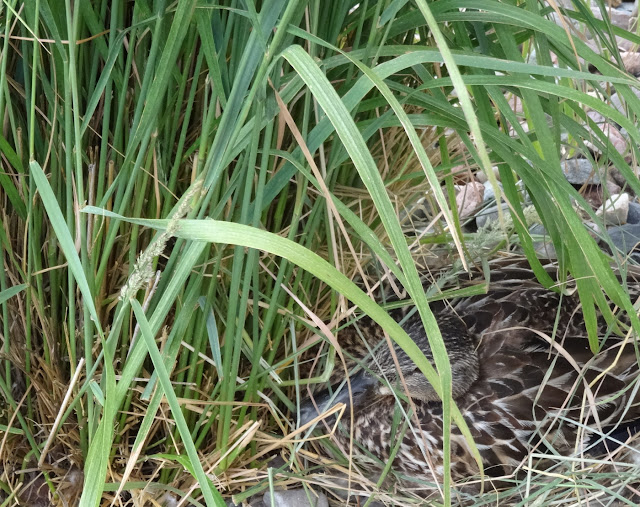6/27/2021
gleeful painted turtle
The painted turtles who live in the pond love to sit in the sun, especially on rocks near the water. There, each can enjoy the warmth and (in case of danger) slip into the water to hide if needed. This young little critter, about 4 inches long, looked so gleeful today with its feet extended out to catch as much sunshine as possible.
new Mallards, second clutch
Mallard female has been hiding her second clutch of eggs near the pond among grasses. Today she led all 6 hatched ducklings to the pond, where they paddled around and started to feed. They can eat seeds, stems, and roots of many different plants; also aquatic invertebrates such as worms, beetles, dragonflies, or insect larvae.
6/25/2021
scouring rush
Scouring Rush Equisetum hyemale grows in the wetland around the pond. It is also called 'horsetail'.
6/24/2021
galls on goldenrod
6/22/2021
widow skimmer
This dragonfly male 'Widow Skimmer' Libellula luctuosa shows off his handsome transparent wings with black and white structural coloration -- the production of color by microscopically structured surfaces fine enough to interfere with visible light.
The grass seedhead on the left is close to the camera and in front of the wing. But the rush stem behind the wing is showing clearly through the transparent wing while the skimmer rests, clasping that stem.
He is probably looking for prey -- other insects such as mosquitoes. To catch prey he will use his legs, and bring prey into his mouth with fangs.
nesting mallard
6/21/2021
great blue heron
Stealthily, this Great Blue Heron appeared on the shore this afternoon. It stood still for only a little while, looking for prey; they eat fish, frogs, aquatic creatures, even small mammals. Is it a male and female? Great Blue Herons Ardea herodias look alike except for their size, so more likely to tell if we can see them in pairs.
6/20/2021
crown vetch
A creeping plant that was used in the past as erosion control on embankments and roadsides, Crown Vetch Securigera varia is sprinkled among the grasses and rushs around the pond. Pretty lavender and purple blossoms among the greens, but it can take over native plants in this area.
Since this is a non-native invasive plant that can compete with native wildflowers, we will be removing it or cutting it back.
6/19/2021
mullein
Several Mullein plants are growing in the riparian zone around the pond. The plants are small rosettes of fuzzy leaves, close to the ground, the first year of their growth. The second year, Common Mullein Verbacum thapsus shoots up a stem clad in very fuzzy leaves topped by a flower spike (left).
Once the flower blooms, it is a brilliant torch of yellow blossoms. Each blossom has 5 petals, and stays open for a short time. Thus, the spike may have only a few blossoms open at a time.
6/17/2021
meal for green heron
Green Herons nest in trees and shrubs near water, or dry woods and orchards as long as it provides seclusion and there is water nearby for foraging fish or frogs.
Last year we saw a Green Heron Butorides virescens several times here on the pond shore, hunting for a meal. To see those previous photos and information about how these birds use tools to hunt, enter heron in the search box at top left then press return.
6/14/2021
6/12/2021
dragonflies
Two large darner dragonflies hovered on pondweed growing in the water. Each dragonfly is over 3 inches long, and more brilliant blue and green colors than the vegetation nearby. They seemed to be connected (with the male grabbing the female by the head with his rear abdomen appendages) which suggests some stage of mating.
6/10/2021
goslings
On closer look, one of the young geese struggled with a piece of plastic netting caught in the hinge of its bill. The gosling was able to keep up with the others but we wonder about its future health.
6/09/2021
mallow
Small wildflowers grow in the riparian area surrounding the pond. Some are invisible to the casual observer because of their small stature, or because they are hidden by the many taller grasses and reeds.
One of these tiny weedy wildflowers is Common Mallow Malva neglecta, with 5 petals of palest pink with stronger pink stripes.
The leaves resemble geraniums but the two families have different reproductive structures.
Mallow is also called 'Cheeseweed' since each seed looks like a miniature wheel of cheese.
6/01/2021
northern blue flag
Iris versicolor, the Northern Blue Flag, is blooming near the pond. It does not mind having its 'feet' wet and often grows in a few inches of water.
The blue to purple flowers stand out from the grasses and reeds around it, but the sword-like leaves blend into all that green!
This plant attracts both butterflies and hummingbirds, and may be known as Blue Flag Iris, Harlequin Blue Flag, Northern Iris, and Wild Iris.























